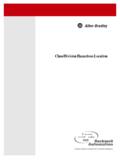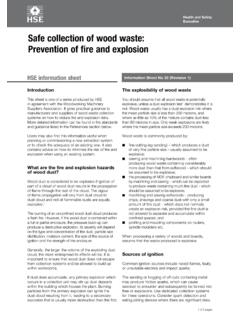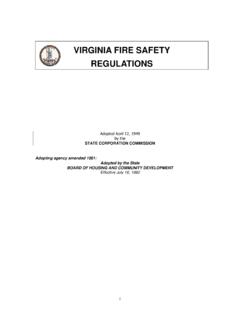Transcription of Preventing Fire and/or Explosion Injury from Small and ...
1 1 Preventing Fire and/or Explosion Injury from Small and Wearable Lithium Battery Powered Devices Safety and Health Information Bulletin SHIB 06-20-2019 Introduction Small and wearable electronic devices used in workplaces ( , body cameras) rely on a power source that stores a high amount of energy in a Small space ( , high energy density). Lithium cells provide sustained power and often have the capability to recharge. When designed, manufactured, and used properly, lithium batteries are a safe, high energy density power source for devices in the workplace.
2 While lithium batteries are normally safe, they may cause Injury if they have design defects, are made of low quality materials, are assembled incorrectly, are used or recharged improperly, or are damaged. In February 2018, the Consumer Product Safety Commission s Status Report on High Energy Density Batteries Project reported over 25,000 overheating or fire incidents involving more than 400 types of lithium battery- powered consumer products that occurred over a five-year period. Image 1. Example of a lithium battery Source/Copyright: OSHA Image 2.
3 Small wearable camera Source/Copyright: Andreas Arnold/picture- alliance/dpa/AP Images Many consumer products have practical applications in Small and large businesses. Ensuring these products will operate safely in workplaces begins with using batteries, chargers, and associated equipment that are tested in accordance with an appropriate test standard ( , UL 2054) and, where applicable, certified by a Nationally Recognized Testing Laboratory (NRTL).i Manufacturer s instructions provide procedures for use, charging, and maintenance that is specific to each device and necessary to prevent damage to the lithium batteries (See Image 1).
4 For example, some batteries will overcharge if a charger is used that does not turn off when the battery is fully charged. Workers who wear or frequently handle lithium-powered devices or batteries are particularly at risk if a lithium battery catches fire or explodes since the device or battery is close to the body. 2 For example, Small cameras worn by workers ( , police and security personnel), as shown in Image 2, can cause burns or other serious Injury if the lithium battery catches fire or explodes while worn.
5 To prevent Injury , it is important for employers and workers to understand a lithium-powered device s basic function, hazards, and safe use. How Lithium Batteries Work The term lithium battery refers to one or more lithium cells that are electrically connected. Like all batteries, lithium battery cells contain a positive electrode, a negative electrode, a separator, and an electrolyte solution. Atoms or molecules with a net electric charge ( , ions) are transferred from a positive electrode to a negative electrode through an electrolyte solution.
6 Lithium cells store and release power by converting chemical potential energy into electrical energy using lithium ions or lithium metal. Electrolyte solutions allow ions to flow freely between the electrodes. Lithium-ion batteries use lithium in ionic form instead of lithium in solid metallic form (See Image 3). They are also usually rechargeable, often without the need to remove them from the device. Lithium-ion batteries power devices such as mobile telephones, laptop computers, tablets, cameras, and power tools.
7 Lithium-metal batteries are generally non-rechargeable and have lithium-metal electrodes. Lithium-metal batteries are generally used to power devices such as watches, calculators, temperature data loggers, car key fobs, flashlights, and defibrillators. Hazards Lithium batteries are generally safe and unlikely to fail, but only so long as there are no defects and the batteries are not damaged. When lithium batteries fail to operate safely or are damaged, they may present a fire and/or Explosion hazard. Damage from improper use, storage, or charging may also cause lithium batteries to fail.
8 Testing batteries, chargers, and associated equipment in accordance with an appropriate test standard ( , UL 2054), NRTL certification (where applicable), and product r ecalls, help identify defects in design, manufacturing, and material quality. Damage to lithium batteries can occur immediately or over a period of time, from physical impact, exposure to certain temperatures, and/or improper charging. Physical impacts t hat can damage lithium batteries include dropping, crushing, andpuncturing. Damage to all types of lithium batteries can occur when temperatures are too high ( , above130 F).
9 External heat sources ( , open flames, heaters, etc.) can also accelerate failure incells with defects or damage from other causes. Damage to lithium-ion batteries can occur when the batteries themselves or the environmentaround the batteries is below freezing (32 F) during charging. Charging in temperatures belowfreezing can lead to permanent metallic lithium buildup ( , plating) on the anode, increasing therisk for failure. Charging a device or battery without following manufacturer s instructions may cause damage torechargeable lithium-ion batteries.
10 For example, some manufacturer-authorized chargers willcycle the power to the battery on and off before it is fully charged to avoid overcharging. Sinceultra-fast chargers may not cycle power, do not use them unless the manufacturer s instructionsinclude them as an 3. Lithium-Ion Cell Discharging Source/Copyright: iStock 3 Heat released during cell failure can damage nearby cells, releasing more heat in a chain reaction known as a thermal runaway. The high energy density in lithium batteries makes them more susceptible to these reactions.














